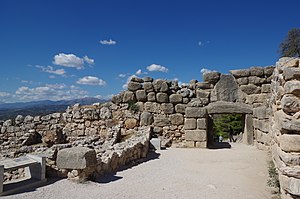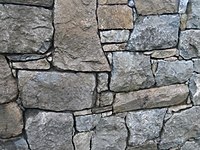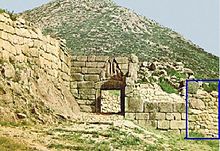Cyclopean masonry

Cyclopean masonryis a type ofstoneworkfound inMycenaeanarchitecture, built with massivelimestoneboulders,roughly fitted together with minimalclearancebetween adjacent stones and withclaymortar or[1]no use ofmortar.The boulders typically seem unworked, but some may have been worked roughly with a hammer and the gaps between boulders filled in with smaller chunks of limestone. It is similar to Indian masonry such as theCyclopean Wall of Rajgir.
The most famous examples of Cyclopean masonry are found in the walls ofMycenaeandTiryns,and the style is characteristic of Mycenaean fortifications. Similar styles of stonework are found in other cultures and the term has come to be used to describe typical stonework of this sort, such as the old city walls ofRajgir.[2]
The term comes from the belief of classical Greeks that only the mythicalCyclopeshad the strength to move the enormous boulders that made up the walls of Mycenae and Tiryns.Pliny'sNatural Historyreported the tradition, attributed toAristotle,that the Cyclopes were the inventors of masonry towers, giving rise to the designation "Cyclopean".[3]
Current definitions
[edit]The walls are usually founded in extremely shallow beddings carved out of the bedrock. "Cyclopean", the term normally applied to the masonry style characteristic of Mycenaean fortification systems, describes walls built of huge, unworked limestone boulders which are roughly fitted together. Between these boulders, smaller chunks of limestone fill the interstices. The exterior faces of the large boulders may be roughly hammer-dressed, but the boulders themselves are never carefully cut blocks. Very large boulders are typical of the Mycenaean walls atMycenae,Tiryns,Argos,Krisa (inPhocis), and theAcropolis of Athens.Somewhat smaller boulders occur in the walls ofMidea,whereas largelimestoneslabs are characteristic of the walls atGla.Cut stone masonry is used only in and around gateways, conglomerate at Mycenae and Tiryns and perhaps both conglomerate and limestone at Argos.[4]
Outdated definitions of the Cyclopean style
[edit]Harry Thurston Peck,writing in 1898, divided Cyclopean masonry into four categories or styles:[5]
1 
Stone wall, Ireland. The first style, which is the oldest, consists of unwrought stones of various sizes in which the gaps are, or were, filled with small stones.
2
A polygonal wall, excavated atDelphiin 1902. The second is characterized by polygonal stones, which fit against each other with precision. 3 
TheLion Gate,atMycenae,with equal-height courses of unequal-width stones The third style is characterized by work made in courses and by stones of unequal size, but of the same height. This category includes structures inPhocis,BoeotiaandArgolis,and the walls ofMycenae,theLion Gate,and theTreasury of Atreus.[6] 4 Walls atRamnous,Attica;some are made of rectangular, but irregular stones (mix of types1and4) The fourth style is characterized by horizontal courses of masonry, not always of the same height, but of stones which are all rectangular. This style is common inAttica.
While Peck's first and possibly second and third styles conform to whatarchaeologiststoday would classify as cyclopean, the fourth now is referred to asashlarand is not considered cyclopean. There is a more detailed description of the Cyclopean styles at thePerseus Project.[7]
Historical accounts
[edit]Pausaniasdescribed the Cyclopean walls of Mycenae andTiryns:
There still remain, however, parts of the city wall [of Mycenae], including the gate, upon which stand lions. These, too, are said to be the work of the Cyclopes, who made forProetusthe wall atTiryns.(2.16.5)Going on from here and turning to the right, you come to the ruins of Tiryns.... The wall, which is the only part of the ruins still remaining, is a work of the Cyclopes made of unwrought stones, each stone being so big that a pair of mules could not move the smallest from its place to the slightest degree. Long ago small stones were so inserted that each of them binds the large blocks firmly together.(2.25.8)

Modern archaeologists use "Cyclopean" in a more restricted sense than the description by Pausanias; while Pausanias attributes all of the fortifications of Tiryns and Mycenae, including the Lion Gate, to the Cyclopes, only parts of these walls are built in Cyclopean masonry. The accompanying photograph shows the difference between Cyclopean masonry (shown in the blue rectangle), and theashlarmasonry of the Lion G
Locations of structures
[edit]The entrance of a Mycenaean citadel in the Bronze Age,Lion Gate,demonstrated the monumentalizing occurring in Greece and showed the power of the citadel.[8]Apart from the Tirynthian and Mycenaean walls, other Cyclopean structures include somebeehive tombsin Greece and the fortifications of a number of Mycenean sites, most famously atGla.
InCyprus,theKitionarchaeological site in present-dayLarnaca,has revealed cyclopean walls.[9]Additionally,Nitovikla,EnkomiandMaa Paleokastro[10]use Cyclopean masonry.
InItaly,polygonal masonry is particularly indicative of the region ofLatium;scholars includingGiuseppe Luglihave carried out studies of the technique.[11][12]Some notable sites that have fortification walls built in this technique includeNorba,Signia,Alatri,Boiano,Circeo,Cosa,Alba Fucens,Palestrina,TerracinaandSanta Severa.One of the largest and least known is the "acropolis" inAlatri,an hour south of Rome. It also seems to have a portal through which the summer solstice sun shines and some think it is also has a number of other astronomical significant points to it. It is thought to be the second largest in Europe, after Athens.[citation needed]InSicily,there are many Cyclopean structures especially inErice,in the western part of the island.[13]TheNuragheof Bronze AgeSardiniaalso are described as being constructed in cyclopean masonry, as are some of the constructions of theTalaiotculture abounding onMenorcaand present to a lesser extent onMallorca.
In the ancient city ofRājagṛha(nowRajgir,Bihar, India), cyclopean walls can be seen.
See also
[edit]- Dry stone
- Megalithicarchitecture
- Stone masonry
- Stone wall
References
[edit]- ^Fletcher, Banister (1905).A History of Architecture on the Comparative Method(5 ed.). p. 54 – via Internet Archive.
- ^"The Cyclopean Wall Rajgir".Travel News India.2017-03-07.Retrieved2017-03-08.
- ^Pliny,Hist. Nat.vii.56.195:turres, ut Aristoteles, Cyclopes [invenerunt].
- ^"Dartmouth.edu Prehistoric Greece site".Archived fromthe originalon 2006-07-22.Retrieved2006-07-21.
- ^Harry Thurston Peck,Harpers Dictionary of Classical Antiquities,1898.
- ^Section of the Treasury of Atreus at Mycenae
- ^Cyclōpesat thePerseus Project
- ^Neer, Richard (2012).Greek Art and Archaeology.Thames and Hudson.ISBN9780500288771.
- ^Karageorghis, Vassos (2002).Early Cyprus: crossroads of the Mediterranean.Los Angeles, California: The J. Paul Getty Museum. pp. 91, 105.ISBN0892366796.
- ^Georgiou, Artemis (2011)."The settlement histories of Cyprus at the opening of the twelfth century BC".Cahiers du Centre d'Études Chypriotes.41(1): 109–131.doi:10.3406/cchyp.2011.1102.
- ^Frank, T.1924. "Roman buildings of the Republic: an attempt to date them from their materials."MAAR3.
- ^Giuseppe Lugli (1957).La Tecnica Edilizia Romana Con Particolare Riguardo a Roma E Lazio: Testo. 1.Johnson Reprint.
- ^"Phoenician Walls of Erice".
External links
[edit]

